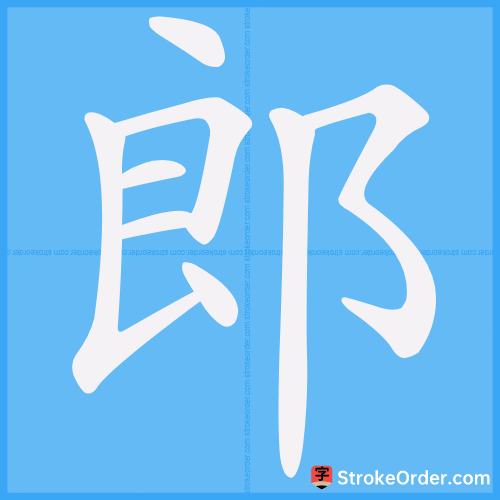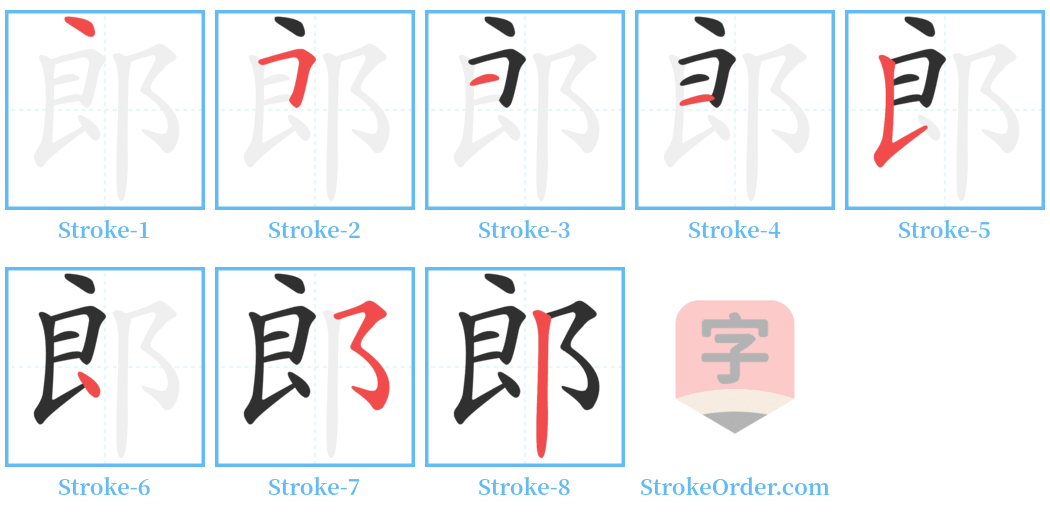郎 Stroke Order
Animated Stroke Order of 郎

Stroke Order Diagrams for 郎

Step-by-Step Handwriting Guide for 郎

Learn to Write Chinese Characters with Video Tutorials
Watch the video of writing the Chinese character "郎", learn the correct stroke order (笔顺) of the character "郎", and master the standard way of writing the character "郎".
Free Printable Handwriting Practice with Stroke Order: 郎
Printable Writing Practice Worksheet of "郎" in Portrait Orientation (Tian Zi Ge)

Printable Writing Practice Worksheet of "郎" in Landscape Orientation (Tian Zi Ge)

Information of 郎
Pinyin
láng、 làng
Radical
阝
Strokes
8 strokes
Usage
★★★★★
Definition
(surname) / a youth
郎 (láng)
名
1. 对年轻男子的称呼。
(A term of address for young men.)
2. 对某种人的称呼。
(A term of address for certain types of individuals.)
3. 旧时妻称夫或情人。
(In ancient times, a term used by wives to refer to their husbands or lovers.)
4. 封建时代的官名。
(An official title during the feudal era.)
5. 姓。
(A surname.)
6. 古地名。春秋鲁邑。
(An ancient place name: Lang town during the Spring and Autumn period.)
7. 在今山东省鱼台县东北,是费伯的食邑。
(Located northeast of Yutai County, Shandong province, it was the fief of Fei Bo.)
8. 在今山东省曲阜县附近。
(Near present-day Qufu County, Shandong province.)
9. 郎,古廊字。原指宫殿廷廊,置侍卫人员所在。
(In ancient texts, "郎" refers to the palace corridor where guards were stationed.)
10. 战国始置。帝王侍从官侍郎、中郎、郎中等的通称。
(Established during the Warring States period, it is a general term for officials who served kings, such as shilang, zhonglang, and langzhong.)
11. 旧时妇女对丈夫或情人的昵称。
(A term of endearment for husbands or lovers used by women in ancient times.)
12. 女婿,女儿的丈夫。
(Son-in-law; the husband of one’s daughter.)
13. 称别人的儿子。
(A term used to refer to someone else's son.)
14. 汉魏以来少年的美称。
(A term of endearment for youths used since the Han and Wei dynasties.)
15. 旧时对从事某种职业者的称呼。
(An archaic term for individuals engaged in specific occupations.)
16. 旧时对一般男子的尊称。
(A respectful address for general men in ancient times.)
17. 仆人称主人为郎。
(A term used by servants to refer to their masters.)
18. 通“廊”。室外有顶的过道。
(Refers to a covered corridor or veranda.)
19. 通“廊”。朝廷。
(Refers to the court.)
20. [屎壳郎] “蜣螂”的俗称。
(A colloquial term for "scarab beetle".)
Cowherd and Weaving maid (characters in folk story) / separated lovers / Altair and Vega (stars)
Input Method for 郎
Pinyin
lang2
Wubi
yvcb|yvbh
Cangjie
iinl
Zhengma
sxy
Four Corner
37727
Unicode
U+90ce
Same Pronunciation Characters